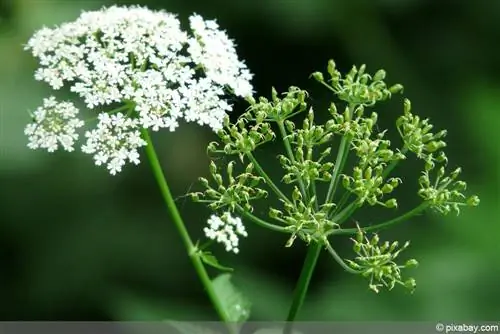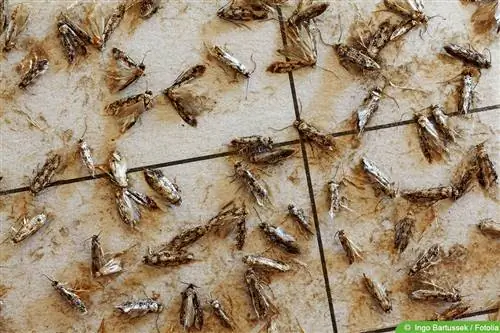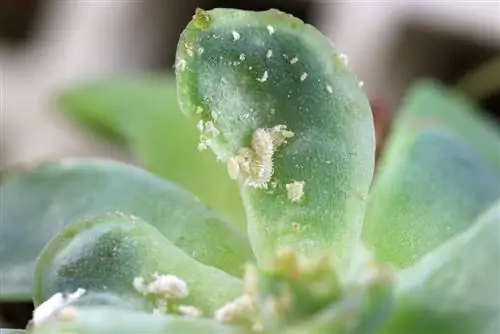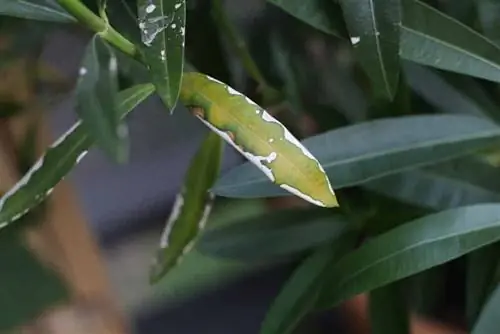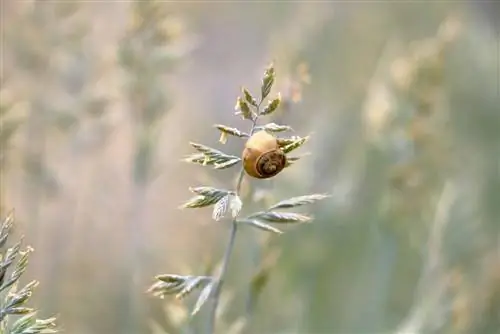- Author admin [email protected].
- Public 2023-12-17 03:39.
- Last modified 2025-06-01 06:48.
The foliage is divided into the petiole and the leaf blade with triple pinnation. If you want to avoid confusion, you should focus primarily on the foliage and less on the flowers. Because these resemble various umbelliferous plants that the gardener may not want to fight.
Identifying gopherfish
- Special characteristics of root weeds -
Even if the flower provides little information and can therefore be neglected if the foliage is identified closely, the following details are endemic to the gourd and allow confusion to be ruled out. Greedweed flowers fall through her:
- terminally located on long stems
- flat dome
- up to 20 individual umbel-containing inflorescences
- the white to reddish color without bracts
- and its hermaphrodite and five-fold flower structure on
In the foliage, the individual feathers are heavily hairy on the underside and have a blue to medium green color on the upper side. The leaflets are ovoid and oval and have jagged edges that taper to a pointed end. With a trained eye and knowledge of all the details of the plant, recognition is not difficult. Further characteristics of gooseneck viewed as a whole are:
- a stem with a triangular cross-section and a hollow interior
- very long white roots up to three millimeters thick
- During the flowering period, a height of up to one meter
- a very early shoot and mostly wintergreen foliage
- numerous offshoots at the location and in the immediate surroundings
The interaction of these characteristics is what distinguishes groundweed from similar umbelliferous plants. However, not only detection but also control should be carried out with the greatest care and attention. The long roots that spread over large areas must be completely removed, but roots of other plants desired in the garden must not be damaged. There is a risk of confusion, for example with the wild carrot, the beavernelle and the hogweed. The foliage and flowers are similar and an accurate distinction is only possible by looking at all characteristics as a whole.
Fighting gophers
- Chop off above-ground plant parts regularly -
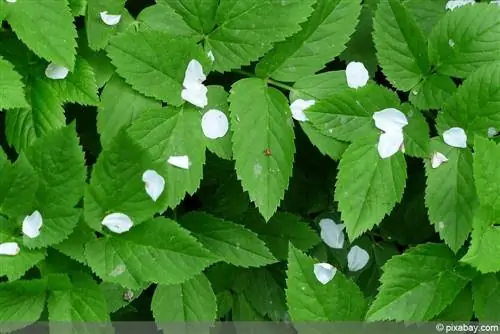
The foliage of the Giersch quickly forms a dense carpet with a height of around 30 centimeters. Only the flowers on their long stems reach a height of up to one meter, which means that the plant is best recognized when it is in bloom and can be distinguished from similar plants. As soon as the first light green shoots appear in spring, combat should begin. If you use this method several times a year, you can limit the growth density of the plant and promote an ever-increasing carpet of groundweed.
However, this practice is very laborious and takes a lot of time. You should also know that the greedweed will still have enough strength to sprout next year and the fight will practically start all over again. Complete and permanent removal requires that you not only fight the above-ground parts of the plant, but especially the rhizome roots and completely remove them from the soil.
Remove roots and rhizomes with a digging fork
So that the plant does not have the strength to sprout again, you should remove the roots from the soil and note that the rhizomes also have to be dug up. This is particularly difficult with older plants, as the roots have already spread over a large area and may even have multiplied under the path slabs in the garden. In loose soils, it is still more effective if you deal directly with the roots and in this way combat the uncontrolled spread of weeds.
Tip:
Don't dig up the ground! Digging has the opposite effect, as you only push the roots deeper into the soil and allow the groundweed to grow practically uncontrollably.
When working with the digging fork, remove all white roots and rhizomes from the soil. The best way to do this is to use a sieve that catches even the smallest root residues. All rhizomes remaining in the soil sprout with new vigor and ensure that your bed does not remain clean and free of weeds for long.
Note:
Do not dispose of the roots and rhizomes in the compost. The gourd has a very strong driving force, which means that with compost fertilization you would automatically ensure that the plant spreads again. It is best to let the removed parts of the plant dry in the sun for several days, which means you can later use them as a natural fertilizer for tomatoes and other plants.
Fighting with a digging fork is particularly recommended in beds, while it is not a suitable method on a lawn. Even in very solid soil, you should refrain from digging and concentrate on the next tip, smothering with fleece.
Smother Greedsh
- Use fleece or cardboard to control weeds -
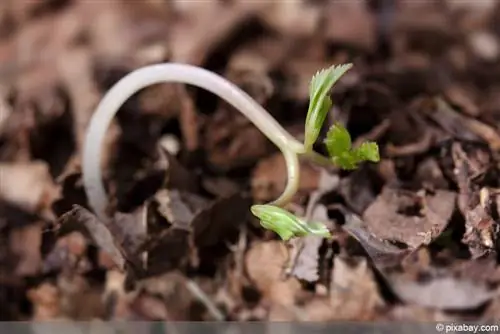
If the groundweed has taken over your lawn or spread under the fruit trees, you can use fleece or sturdy cardboard to combat the weeds. A thick layer of bark mulch is also advisable and is the most natural way to combat Girsch. This method is simple, but requires a lot of patience and is therefore best recommended for less used areas on the property that are not in the visible area. The cardboard or bark mulch needs about two years to completely rot, which you should wait for if you plan to smother the weeds. If the cardboard has rotted, the rhizomes have died and your property should be free of weedweed.
If you work with fleece, you can also choose this method for your beds. However, since an area covered with fleece is less visually appealing, this practice is only an option for very few gardeners. You don't have to forego planting, as you can cut slits in the fleece and insert perennials. So that the permanently applied cover does not attract attention, it can be covered with a thick layer of bark mulch. In most cases, goosegrass does not sprout and the bed is free of weeds.
Note:
Even if the rhizomes die and the groundweed no longer sprouts, the long shelf life of the seeds should not be forgotten. If fleece, cardboard or bark mulch is removed too early, the seeds in the soil will quickly form new and strong greed plants.
Potatoes are good and natural weed killers
When combating groundweed, hardly any gardener thinks of potatoes, but they are certainly suitable as a natural weed killer and therefore also suitable for combating groundweed. Potato plants have very dense foliage that casts the soil beneath them in complete shade. Since potatoes have high nutrient and water requirements, they deprive weeds of many nutrients and make it almost impossible for the gourd plant to grow. Potatoes are recommended as a weed killer, for example:
- in newly created gardens that are therefore very susceptible to weeds
- on large properties that offer enough space for potato beds
- for very hard soils that are loosened up by potatoes
- if weeds are very strong
No matter what method you choose, once you spot the weeds you need to take action. Do not wait any longer than necessary, as groundweed is a very fast-growing plant with numerous roots. The season plays a minor role here, even if the main budding occurs at the beginning of spring. In late summer or autumn, discover the smallest shoots of the gooseweed, remove them along with the roots and don't wait until next spring.
Stubborn infestation - chemical control?
For every weed there is a corresponding remedy that you can use to curb the growth and ensure weed-free beds. However, resorting to a chemical should be the last and best avoided resort. Because the chemical club penetrates the soil and is therefore not only absorbed by weeds, but also by your crops. If you care for vegetable beds or fruit trees in the garden, you should definitely avoid chemicals and opt for natural, manual control of groundweed.
Girsch in the perennial bed
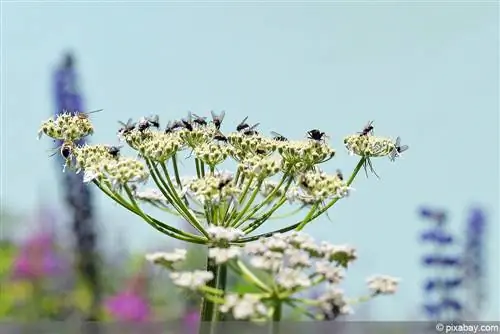
Removing stubborn weeds is particularly easy in beds with perennials. Since you remove the perennials in the fall, you can then fight the groundweed's roots and free your bed of the plant's rhizomes. The digging fork with the recommended sieve, which you read about in a previous paragraph, is suitable here.
When rhizomes spread under paths
On properties that have been vacant for a long time, the weeds have had a lot of time to spread throughout the area and form numerous rhizomes under the paths, the terrace or even on the foundation of the house. When gardeners recognize this problem, control should occur before garden planning. Rhizome roots under garden paths or under walls are easy to identify because they cause the path slabs to rise or walls to tilt. Occasionally, parts of roots can be seen above ground as they grow out between the individual slabs or between paving stones. To carry out complete removal, the panels must be removed and any roots underneath must be carefully removed from the soil.
Tip:
Gedweed is the weed most feared by gardeners. Due to its persistence and rapid spread over large areas on the property, it is particularly important that control is carried out carefully, consistently and with the right tools. When focusing on natural removal, including the roots, the gardener should check several times a year and keep an eye on the areas covered with groundweed over the long term. Fighting weeds just once doesn't mean they won't grow again. Even if the roots and rhizomes are removed, renewed spread via the plant's durable and very germinable seeds cannot be ruled out.

